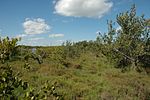Horti Point
Headlands of FloridaIndian River LagoonLandforms of Brevard County, FloridaMerritt Island, Florida
Horti Point is a headland on Merritt Island in Brevard County, Florida.
Excerpt from the Wikipedia article Horti Point (License: CC BY-SA 3.0, Authors).Horti Point
Eastwood Drive,
Geographical coordinates (GPS) Address Nearby Places Show on map
Geographical coordinates (GPS)
| Latitude | Longitude |
|---|---|
| N 28.322222222222 ° | E -80.66 ° |
Address
Eastwood Drive 2001
32952
Florida, United States
Open on Google Maps





